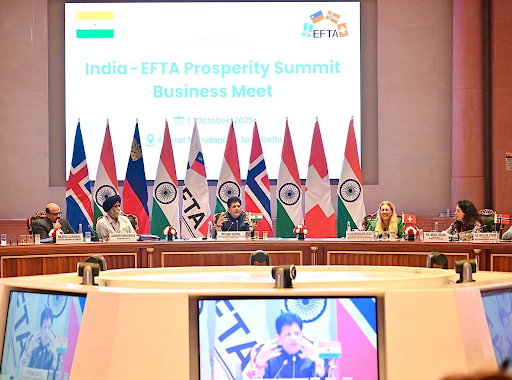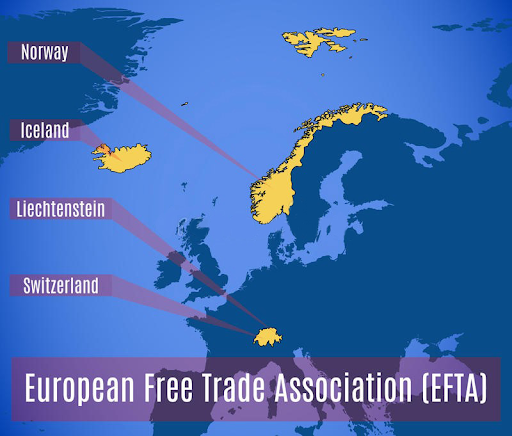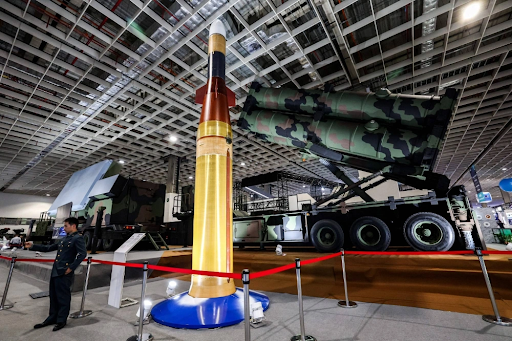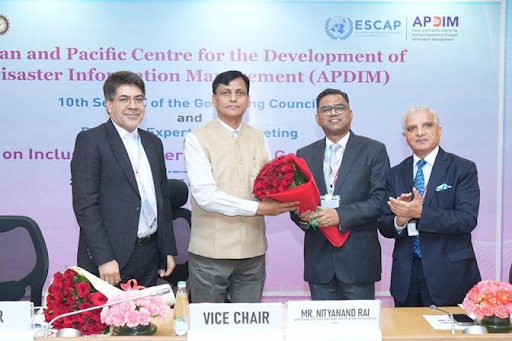



The India-EFTA TEPA pledges $100 billion FDI and 1 million jobs, boosting “Make in India” and “Atmanirbhar Bharat.” While it strengthens India’s trade and innovation profile, challenges like data exclusivity and trade imbalances must be managed to ensure balanced, equitable, and sustainable long-term growth.

Copyright infringement not intended
Picture Courtesy: NEWSONAIR
The India–European Free Trade Association (EFTA) Trade and Economic Partnership Agreement (TEPA) came into effect on 1st October 2025.
|
Read all about: INDIA-EFTA FREE TRADE AGREEMENT |
It is a comprehensive Free Trade Agreement signed between India and the European Free Trade Association (EFTA), comprising Switzerland, Norway, Iceland, and Liechtenstein.

It is India’s first FTA linking trade, investment, and job creation, to boost economic ties with the technologically advanced, non-EU European nations.
It was signed in March 2024 in New Delhi, and became operational from 1st October 2025.
Investment and Employment
Market Access for Goods
Services and Mobility
Intellectual Property Rights (IPR)
Adheres to TRIPS (Trade-Related Aspects of Intellectual Property Rights) standards but includes safeguards to prevent patent evergreening, protecting Indian generic pharmaceutical industry while promoting innovation.
Sustainable Development
Promotes green growth, environmental protection, and social inclusion through collaboration in renewable energy, precision engineering, and health sciences.
Unique Investment Commitment: Unlike other FTAs (e.g., India-UAE, India-Australia, India-UK), TEPA includes binding $100 billion FDI pledge, directly tied to job creation.
Sustainability Focus: TEPA’s emphasis on green technology, clean energy, and human rights is more advanced than older FTAs, aligning with global trends in sustainable trade.
Data Exclusivity Concerns: Similar to FTAs with developed nations, TEPA’s Intellectual property Rights (IPR) provisions challenge India’s generic pharma industry, unlike agreements with UAE or Australia, which have less focus on pharmaceuticals.
Partner Profile: EFTA comprises small, high-tech economies, unlike the diverse profiles of UAE (oil, trade) or Australia (agriculture, minerals).
Economic Growth: The $100 billion FDI commitment will drive growth in manufacturing, services, and infrastructure, creating direct and indirect jobs.
Boosting Exports: Zero-duty access to EFTA markets boosts competitiveness of Indian pharmaceuticals, textiles, and IT services, reducing trade costs in high-income EFTA markets.
Support for National Initiatives: Aligns with “Make in India” and “Atmanirbhar Bharat” by encouraging EFTA investments in infrastructure, chemicals, pharmaceuticals, machinery, and food processing.
Technology Transfer: Access to advanced technologies in renewable energy, precision engineering, and health sciences encourages innovation.
Diversification of Supply Chains: Reduces reliance on single markets (e.g., USA, China), reducing vulnerabilities to global disruptions (e.g., pandemics or geopolitical tensions) by facilitating resilient supply chains for raw materials and finished goods.
Global South Leadership: TEPA positions India as a hub for sustainable development and technology collaboration, reinforcing its role as a voice for the Global South in trade negotiations.
Asymmetric Trade Benefits: India opens 82.7% of its tariff lines, while EFTA offers 92.2%. Critics argue that India’s concessions, especially on gold imports, may disproportionately benefit EFTA.
Trade Deficit: In 2024, India’s imports from EFTA ($32.4 billion; including $18bn Gold) far exceeded exports ($2 billion). TEPA could expand the trade deficit.
Exclusion of Sensitive Sectors: India’s exclusion of dairy, coal, and certain agricultural goods may limit mutual benefits and create friction with EFTA nations seeking broader access.
Implementation Challenges: Effective implementation of Mutual Recognition Agreements (MRAs) and technology transfer requires robust institutional frameworks, which may face bureaucratic delays.
Strategic Implementation: Establish robust mechanisms to monitor FDI inflows and ensure job creation targets are met.
Safeguard Generic Pharma: Leverage TEPA’s safeguards against patent evergreening to protect India’s generic drug industry while collaborating on innovation.
Selective Engagement: Prioritize non-sensitive sectors (e.g., renewables, IT services) for cooperation while protecting sensitive sectors like dairy and agriculture.
Strengthen MRAs: Fast-track Mutual Recognition Agreements to facilitate professional mobility and boost service exports.
Balance Trade Deficit: Promote export diversification to EFTA markets, focusing on high-value goods like pharmaceuticals and jewelry to reduce the trade imbalance.
Leverage Global Platforms: Use TEPA to strengthen India’s position in global trade forums (e.g., WTO, G20), advocating for inclusive and sustainable trade policies.
The India-EFTA TEPA pledges $100 billion FDI and 1 million jobs, boosting “Make in India” and Atmanirbhar Bharat. Despite concerns over data exclusivity and trade imbalances, strategic implementation can enhance India’s global manufacturing and innovation leadership.
Source: NEWSONAIR
|
PRACTICE QUESTION Q. Consider the following statements about the Trade and Economic Partnership Agreement (TEPA):
Which of the above statements is/are correct? A) 1 only B) 2 only C) Both 1 and 2 D) Neither 1 nor 2 Answer: C Explanation: Statement 1 is correct: The Trade and Economic Partnership Agreement (TEPA) is a Free Trade Agreement (FTA) signed between India and the European Free Trade Association (EFTA) nations. Statement 2 is correct: The European Free Trade Association (EFTA) is an intergovernmental organization that promotes free trade and economic integration among its four member states: Iceland, Liechtenstein, Norway, and Switzerland. |
It is a comprehensive free trade agreement between India and the four European Free Trade Association (EFTA) member states.
The EFTA member countries are Switzerland, Norway, Iceland, and Liechtenstein.
EFTA has committed to promoting foreign direct investment (FDI) in India by aiming for a total of $100 billion over 15 years, with the goal of creating one million direct jobs in India.







© 2025 iasgyan. All right reserved